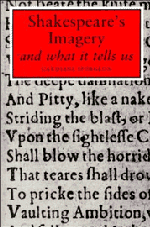Book contents
- Frontmatter
- ACKNOWLEDGEMENTS
- PREFACE
- Contents
- ILLUSTRATIONS
- Part I THE REVELATION OF THE MAN
- I The Aim and Method explained
- II Shakespeare's Imagery compared with that of Marlowe and Bacon
- III Imagery of Shakespeare and other Dramatists compared
- IV The Subject-matter of Shakespeare's Images
- V Shakespeare's Senses
- VI Shakespeare's Tastes and Interests
- VII Shakespeare's Tastes and Interests (continued)
- VIII Evidence in the Images of Shakespeare's Thought
- IX Evidence in the Images of Shakespeare's Thought (continued)
- X Association of Ideas
- XI Shakespeare the Man
- Part II THE FUNCTION OF THE IMAGERY AS BACKGROUND AND UNDERTONE IN SHAKESPEARE'S ART
- APPENDICES
- INDEX
- CHARTS
I - The Aim and Method explained
Published online by Cambridge University Press: 20 February 2010
- Frontmatter
- ACKNOWLEDGEMENTS
- PREFACE
- Contents
- ILLUSTRATIONS
- Part I THE REVELATION OF THE MAN
- I The Aim and Method explained
- II Shakespeare's Imagery compared with that of Marlowe and Bacon
- III Imagery of Shakespeare and other Dramatists compared
- IV The Subject-matter of Shakespeare's Images
- V Shakespeare's Senses
- VI Shakespeare's Tastes and Interests
- VII Shakespeare's Tastes and Interests (continued)
- VIII Evidence in the Images of Shakespeare's Thought
- IX Evidence in the Images of Shakespeare's Thought (continued)
- X Association of Ideas
- XI Shakespeare the Man
- Part II THE FUNCTION OF THE IMAGERY AS BACKGROUND AND UNDERTONE IN SHAKESPEARE'S ART
- APPENDICES
- INDEX
- CHARTS
Summary
I know I am talking of a trite and threadbare theme—namely, figures of speech. But the trite we fight shy of because it is trite, is sometimes more shining than the upstart new, if we will but brush off the dust.
Convention and Revolt in Poetry, John Livingston Lowes.When Polonius instructs his man Reynaldo how best to find out what kind of life his son is leading in Paris, he suggests various circuitous ways of extracting information from Laertes' friends, such as hinting that he games or drinks, and noting how they receive such hints, and so by the judicious use of these indirect methods to draw forth the truth.
He illustrates his meaning by a metaphor from bowls; a game Shakespeare was interested in, and in which the curious fact that the player does not aim directly at the jack, but sends his ball in a curve, trusting to the bias to bring it round again, greatly appealed to him.
Thus, says Polonius, characteristically, do we men of wisdom and capacity, with winding ways
and with assays of bias,
By indirections find directions out.
These lines describe so exactly what I propose to try and do in this book, that ‘assays of bias’ might well have served as title for it, could these words have been more easily understood by modern readers. I venture moreover to say I believe the game would have appealed to Shakespeare, for just as he was attracted by the subtle element in bowls, and the measure of skill and judgment needed to turn an indirect aim into a good and true hit, so would he have been interested in the working of the same method in the sphere of literature and psychology.
- Type
- Chapter
- Information
- Shakespeare's Imagery and What it Tells Us , pp. 3 - 11Publisher: Cambridge University PressPrint publication year: 1935



